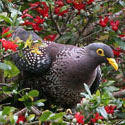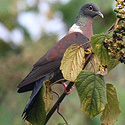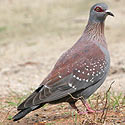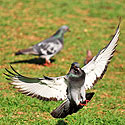|
Columba (pigeons)
Life
> Eukaryotes >
Opisthokonta
> Metazoa (animals) >
Bilateria >
Deuterostomia > Chordata >
Craniata > Vertebrata (vertebrates) > Gnathostomata (jawed
vertebrates) > Teleostomi (teleost fish) > Osteichthyes (bony fish) > Class:
Sarcopterygii (lobe-finned
fish) > Stegocephalia (terrestrial
vertebrates) > Tetrapoda
(four-legged vertebrates) > Reptiliomorpha > Amniota >
Reptilia (reptiles) >
Romeriida > Diapsida > Archosauromorpha > Archosauria >
Dinosauria
(dinosaurs) > Saurischia > Theropoda (bipedal predatory dinosaurs) >
Coelurosauria > Maniraptora >Aves
(birds) > Order: Columbiformes >
Family: Columbidae
Species indigenous to southern Africa
(* = naturalised)
|
Columba arquatrix
(African olive-pigeon, Rameron pigeon) The
African olive pigeon is found mainly in South Africa, with a small
population on the border between Mozambique and Zimbabwe. It lives mainly in
indigenous forests, as well as suburban gardens and parks, where it can be
found in fruit trees or bushes, its main source of food. The female builds
the nest, with the male collecting the material, and putting it on the
female's back, who then puts it underneath her body. It lays 1-2 eggs, which
are incubated by both sexes, changing shifts in the early morning and late
afternoon. The chicks are fed by both parents, and leave the nest after
19-20 days. |
 |
|
Columba
delegorguei (Eastern bronze-naped pigeon, Delegorgue's
pigeon) |
 |
|
Columba
guinea (Speckled pigeon, Rock pigeon)
The Speckled pigeon is common in many places in southern Africa, especially
in South Africa. It usually lives in rocky, mountainous areas, but can also
be found in buildings and gardens. It feeds mostly on seeds, rarely eating
small fruits and flowers. The nest is usually placed on ledges, gullies or
buildings, and is built by the female, with the male collecting the
material. It lays 1-3 eggs, which are incubated by both sexes. The chicks
are brooded for the first 6 days of their lives, after which brooding
ceases. The nestling period is highly variable with different regions, full
range 21-37 days. |
 |
|
* Columba
livia (Rock dove, Feral Pigeon)
The Rock dove is originally native to SE Europe, SW Asia, India, Arabia, N
Africa and British Isles but is now common in many southern African cities, as
well as other cities around the world. It has been selectively bred into a wide
variety of colours, such as a mix of white, grey and fluorescent green. It feeds mainly on seeds, other plant
matter and discarded food left by humans. Both sexes build the nest, which
usually placed in buildings and bridges. It lays 1-2 eggs, which are incubated
by both sexes, for 16-19 days. In Europe, the chicks stay in the nest for 35-37
days, before fledging, at which point they become fully independent.
|
 |
|
